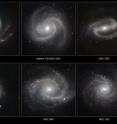Spiral galaxies stripped bare
I [1] is one of the newest and most powerful cameras on ESO's Very Large Telescope (VLT). It is sensitive to infrared light, which means that much of the obscuring dust in the galaxies' spiral arms becomes transparent to its detectors. Compared to the earlier, and still much-used, VLT infrared camera ISAAC, HAWK-I has sixteen times as many pixels to cover a much larger area of sky in one shot and, by using newer technology than ISAAC, it has a greater sensitivity to faint infrared radiation [2]. Because HAWK-I can study galaxies stripped bare of the confusing effects of dust and glowing gas it is ideal for studying the vast numbers of stars that make up spiral arms. The six galaxies are part of a study of spiral structure led by Preben Grosbøl at ESO. These data were acquired to help understand the complex and subtle ways in which the stars in these systems form into such perfect spiral patterns.
The first image shows NGC 5247, a spiral galaxy dominated by two huge arms, located 60-70 million light-years away. The galaxy lies face-on towards Earth, thus providing an excellent view of its pinwheel structure. It lies in the zodiacal constellation of Virgo (the Maiden).
The galaxy in the second image is Messier 100, also known as NGC 4321, which was discovered in the 18th century. It is a fine example of a "grand design" spiral galaxy — a class of galaxies with very prominent and well-defined spiral arms. About 55 million light-years from Earth, Messier 100 is part of the Virgo Cluster of galaxies and lies in the constellation of Coma Berenices (Berenice's Hair, named after the ancient Egyptian queen Berenice II).
The third image is of NGC 1300, a spiral galaxy with arms extending from the ends of a spectacularly prominent central bar. It is considered a prototypical example of barred spiral galaxies and lies at a distance of about 65 million light-years, in the constellation of Eridanus (the River).
The spiral galaxy in the fourth image, NGC 4030, lies about 75 million light-years from Earth, in the constellation of Virgo. In 2007 Takao Doi, a Japanese astronaut who doubles as an amateur astronomer, spotted a supernova — a stellar explosion that is briefly almost as bright as its host galaxy — going off in this galaxy.
The fifth image, NGC 2997, is a spiral galaxy roughly 30 million light-years away in the constellation of Antlia (the Air Pump). NGC 2997 is the brightest member of a group of galaxies of the same name in the Local Supercluster of galaxies. Our own Local Group, of which the Milky Way is a member, is itself also part of the Local Supercluster.
Last but not least, NGC 1232 is a beautiful galaxy some 65 million light-years away in the constellation of Eridanus (the River). The galaxy is classified as an intermediate spiral galaxy — somewhere between a barred and an unbarred spiral galaxy. An image of this galaxy and its small companion galaxy NGC 1232A in visible light was one of the first produced by the VLT (eso9845). HAWK-I has now returned to NGC 1232 to show a different view of it at near-infrared wavelengths.
As this galactic gallery makes clear, HAWK-I lets us see the spiral structures in these six bright galaxies in exquisite detail and with a clarity that is only made possible by observing in the infrared.
Source: ESO
Other sources
- Spiral galaxies stripped barefrom Science DailyWed, 27 Oct 2010, 15:31:16 UTC
- Spiral galaxies stripped barefrom Science BlogWed, 27 Oct 2010, 14:30:33 UTC
- Spiral galaxies stripped barefrom PhysorgWed, 27 Oct 2010, 14:30:27 UTC
- Six Spiral Galaxies Shine Bright in New Photosfrom Space.comWed, 27 Oct 2010, 11:30:38 UTC
